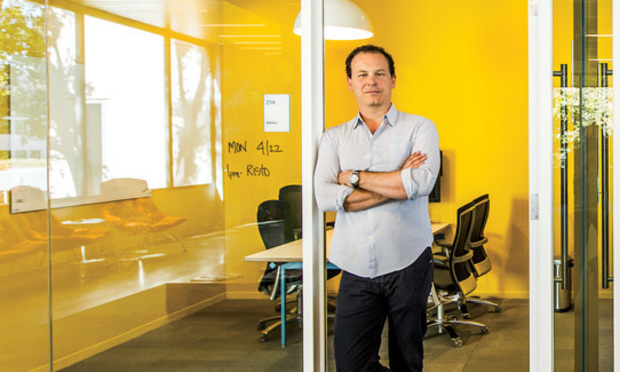New Data Analytics Tool Knows Every Federal Judge's Favorite Cases
Need help on that brief? By turning judicial opinions into sortable data, LexisNexis' Context tool may know judges better than they know themselves.
November 29, 2018 at 08:00 AM
5 minute read
 Nik Reed, before Ravel Law's purchase by LexisNexis. (Courtesy photo: Eric Millette)
Nik Reed, before Ravel Law's purchase by LexisNexis. (Courtesy photo: Eric Millette)
U.S. District Judge William Alsup has ruled on 864 motions to dismiss in his career on the bench in the Northern District of California. He has granted 52 percent of them, tossed 25 percent and split the baby on 23 percent.
The case he is most likely to cite when deciding on those motions? Cited 425 times, Bell Atl. Corp. v. Twombly is a watershed 2007 U.S. Supreme Court Case that raised the bar a plaintiff must plead in order to proceed.
This kind of data—for every federal judge and for 100 different types of motions—is now available to litigators at the click of a mouse through a launch on Thursday of LexisNexis Context, the result of the legal giant's purchase of Ravel Law in mid-2017. Context will be available as an added purchase in the Lexis Advance suite.
In addition to judges' favored citations and motion outcomes, Context tool has sortable data on 380,000 expert witnesses that have appeared in federal court. Want to know for sure if your expert has the goods? Check how many times they've had their testimony thrown out, and for what reasons.
“You can very literally take the judge's own language and insert it into your own motion,” said Nik Reed, co-founder of Ravel Law and now a senior director of product and strategy at LexisNexis. “So you are speaking directly to the judge.”
The launch represents a next step for legal analytics, which have not been used to detail the specific language and cases judges are most likely to cite or the reasons why expert testimony gets tossed.
LexisNexis is not alone in its pursuit of legal analytics.
Companies such as Gavelytics, Premonition and others have focused on analyzing judges' behavior and lawyers' success rates in state courts. LexisNexis' Lex Machina tool, which it acquired in 2017, has analyzed case types and judge's broader behavior, such as how long they typically take to issue rulings and how likely they are to rule on certain matters.
LexisNexis for the past 1½ years has been integrating Ravel Law's technology into its Lexis Advance platform. That will lead to other products, Reed said, such as an analysis of how often cases that lawyers cite in their briefs are used in a judge's opinions. The company also plans to incorporate data from its Shepherd tool to determine how often judges are following or departing from certain case citations.
“It's only recently that technology has caught up to textual-based documents to be able to do this,” Reed said. “It used to be search and retrieval. Enter a keyword and try and find the best document you can from that keyword search. But now you can go beyond that and say what is the meaning behind these different sentences that judges and attorneys are writing. And you can classify that to create powerful insights.”
Litigators with access to Ravel Law have already been using some of the power of the new Context tool to change their behavior when litigating cases, Reed said. In one instance, he said a New York-based lawyer was told by a California judge that a certain motion the lawyer filed was never granted in California. Using analytics, the lawyer showed the judge that he had approved the motion four times in previous years, leading the judge to “begrudgingly” approve the motion, Reed said.
“When you rationally walk through what happens from people having this technology, you hopefully will start to get judges starting to rule more consistently, and maybe the application of the law gets a better service out of this kind of tool,” Reed said. “We need a lot of people to use it and study it before that can happen, but given the sheer amount of data that attorneys have to wrangle these days, having tools that can directionally help you is super helpful.”
Still, there is a question of how welcoming lawyers will be to incorporate data that contradicts their own personal experiences or beliefs about certain judges.
Rick Merrill, a former Greenberg Traurig litigator who launched Gavelytics in 2015 to give insights into California state court rulings, said there is still some resistance to data among lawyers. But he said success stories have helped the cause.
In one instance, he said a partner at a major law firm asked colleagues about a certain judge's tendencies in a California state court. The partner's colleagues responded with a suggestion to use a local rule to request a new judge. But, using Gavelytics, the lawyer found that the judge was statistically more likely than most to agree to a motion to compel arbitration. The lawyer shared that data with opposing counsel, and both sides agreed to arbitration without ever filing the motion, Merrill said.
“Fast-forward a couple of years, and it will be absolutely unthinkable to not study your judge or to not study the lawyer you're going to hire in a statistical fashion,” Merrill said. “People will look back and laugh and say, 'Can you believe we used to not do this stuff?' There is so much change coming in litigation.”
This content has been archived. It is available through our partners, LexisNexis® and Bloomberg Law.
To view this content, please continue to their sites.
Not a Lexis Subscriber?
Subscribe Now
Not a Bloomberg Law Subscriber?
Subscribe Now
NOT FOR REPRINT
© 2025 ALM Global, LLC, All Rights Reserved. Request academic re-use from www.copyright.com. All other uses, submit a request to [email protected]. For more information visit Asset & Logo Licensing.
You Might Like
View All
Alston & Bird Adds M&A, Private Equity Team From McDermott in New York
4 minute read
Veteran Federal Trade Law Enforcer Joins King & Spalding in Washington
4 minute read
Houston Trial Lawyer Mary-Olga Lovett Leaves King & Spalding to Open Boutique
3 minute readTrending Stories
- 1Snapshot Judgement: The Case Against Illustrated Indictments
- 2Texas Supreme Court Grapples Over Fifth Circuit Question on State Usury Law
- 3Exploring the Opportunities and Risks for Generative AI and Corporate Databases: An Introduction
- 4Farella Elevates First Female Firmwide Managing Partners
- 5Family Court 2024 Roundup: Part I
Who Got The Work
J. Brugh Lower of Gibbons has entered an appearance for industrial equipment supplier Devco Corporation in a pending trademark infringement lawsuit. The suit, accusing the defendant of selling knock-off Graco products, was filed Dec. 18 in New Jersey District Court by Rivkin Radler on behalf of Graco Inc. and Graco Minnesota. The case, assigned to U.S. District Judge Zahid N. Quraishi, is 3:24-cv-11294, Graco Inc. et al v. Devco Corporation.
Who Got The Work
Rebecca Maller-Stein and Kent A. Yalowitz of Arnold & Porter Kaye Scholer have entered their appearances for Hanaco Venture Capital and its executives, Lior Prosor and David Frankel, in a pending securities lawsuit. The action, filed on Dec. 24 in New York Southern District Court by Zell, Aron & Co. on behalf of Goldeneye Advisors, accuses the defendants of negligently and fraudulently managing the plaintiff's $1 million investment. The case, assigned to U.S. District Judge Vernon S. Broderick, is 1:24-cv-09918, Goldeneye Advisors, LLC v. Hanaco Venture Capital, Ltd. et al.
Who Got The Work
Attorneys from A&O Shearman has stepped in as defense counsel for Toronto-Dominion Bank and other defendants in a pending securities class action. The suit, filed Dec. 11 in New York Southern District Court by Bleichmar Fonti & Auld, accuses the defendants of concealing the bank's 'pervasive' deficiencies in regards to its compliance with the Bank Secrecy Act and the quality of its anti-money laundering controls. The case, assigned to U.S. District Judge Arun Subramanian, is 1:24-cv-09445, Gonzalez v. The Toronto-Dominion Bank et al.
Who Got The Work
Crown Castle International, a Pennsylvania company providing shared communications infrastructure, has turned to Luke D. Wolf of Gordon Rees Scully Mansukhani to fend off a pending breach-of-contract lawsuit. The court action, filed Nov. 25 in Michigan Eastern District Court by Hooper Hathaway PC on behalf of The Town Residences LLC, accuses Crown Castle of failing to transfer approximately $30,000 in utility payments from T-Mobile in breach of a roof-top lease and assignment agreement. The case, assigned to U.S. District Judge Susan K. Declercq, is 2:24-cv-13131, The Town Residences LLC v. T-Mobile US, Inc. et al.
Who Got The Work
Wilfred P. Coronato and Daniel M. Schwartz of McCarter & English have stepped in as defense counsel to Electrolux Home Products Inc. in a pending product liability lawsuit. The court action, filed Nov. 26 in New York Eastern District Court by Poulos Lopiccolo PC and Nagel Rice LLP on behalf of David Stern, alleges that the defendant's refrigerators’ drawers and shelving repeatedly break and fall apart within months after purchase. The case, assigned to U.S. District Judge Joan M. Azrack, is 2:24-cv-08204, Stern v. Electrolux Home Products, Inc.
Featured Firms
Law Offices of Gary Martin Hays & Associates, P.C.
(470) 294-1674
Law Offices of Mark E. Salomone
(857) 444-6468
Smith & Hassler
(713) 739-1250











